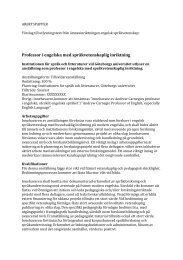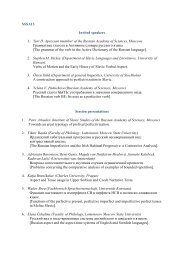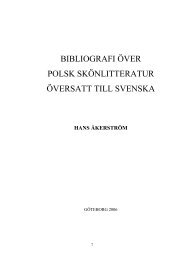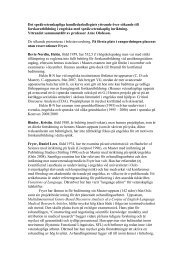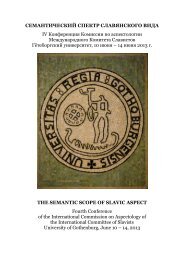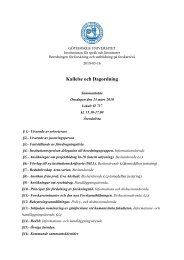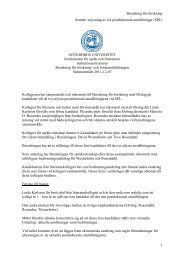temporary Finnish folk music. 29I asked Minna, “What generally are the intentions behind the style of fusion (or hybrid) musicyou have developed, and does it have a distinctive atmosphere or meaning that is different fromother kinds of music?,” and she gave the following reply:“My music is influenced both by Finnish folk music and by the Japanese koto tradition. I’malways interested in finding new sound combinations between instruments and new techniquesin playing. I started to combine the sound of kantele and koto in year 1998 in Finland and thisis Japanese how my composing music and to culture koto started yet also . . . My have first roots music in contemporary piece for koto and Finnish kantele folk was music. “Kanjiki”29(1998). I think there is something magical in the sound of koto, something that touches peoplethrough all ages with beauty, power and intimate sound. Nature is a very important source forI asked Minna, “What generally are the intentions behind the style of fusion (or hybrid) music youme, for inspiration. My composition “Koto” (2003) started with the idea of fire sparks in the logfire. have “Ensilumi” developed, (The and First does Snow) it have is inspired a distinctive by the beauty atmosphere of the first or meaning snow that the branches is different of the from othertrees in my hometown. One other important thing in my composition process is using the traditionalkindsJapaneseof music?,”poetry,andwhichshe gavealso lendsthe followingits own unmistakablereply:atmosphere to the songs.”Figure 5: Minna Padilla Figure 6: Helsinki Koto Ensemble“My music is influenced both by Finnish folk music and by the Japanese koto tradition. I’m alwaysOriginallyinterestedtrainedin findingas a Finnishnew soundfolk musiciancombinationsat thebetweenSibeliusinstrumentsAcademy, Minnaand newstudiedtechniqueskotoin playing.I started to combine the sound of kantele and koto in year 1998 in Finland and this is how mybriefly at both the Tokyo National University of Fine Arts and the Hokkaido University of Education,where there her is something prior musical magical training the and sound technique of koto, enabled something her that to learn touches remarkably people through quickly. all agescomposing to koto started . . . My first music piece for koto and kantele was “Kanjiki” (1998). I thinkHowever, with the beauty, style of power music and that intimate she would sound. eventually Nature develop is a very is important quite different source from for me, traditional for inspiration.Japanese My koto composition playing. Minna “Koto” described (2003) started Japanese with responses the idea of to fire her sparks own in koto the ensemble log fire. “Ensilumi” music as (TheFirst Snow) is inspired by the beauty of the first snow in the branches of the trees in my hometown.follows:One other important thing in my composition process is using the traditional Japanese poetry,which “My music also lends group, its Minna own Padilla unmistakable & The Helsinki atmosphere Koto Ensemble, to the songs.” went to tour to Japan for theFigure 4: Album: Ilta VuorellaFigure 4: Album: Ilta Vuorellafirst time in 2006. I was anxious to know how the Japanese people would react to me playing the29 Tina K. Ramnarine, Ilmatar’s Inspirations: Nationalism, Globalization, and the Changing Soundscapes ofFinnish Folk Music (University of Chicago Press, 2003).<strong>Cultural</strong> translation and Music33
koto and also to my group and koto combined with Finnish national instrument kantele, woodenflutes, Figure percussions, 5: Minna accordion, Padilla electric bass guitar and Figure voice. 6: The Helsinki reaction Koto from Ensemble Japanese peoplewas very positive towards my music and our playing. They even said that my music felt like walkinginto a Finnish forest, gives you feeling like falling in love. My wonderful koto teacher YukikoOriginally trained as a Finnish folk musician at the Sibelius Academy, Minna studied koto briefly atTakagaki requested us to visit her home and we played also there as a vocal and koto duo. Shewas both interested the Tokyo in my National compositions University and thought of Fine that Arts this and is a the new Hokkaido style to play University the koto.” of Education, where herprior musical training and technique enabled her to learn remarkably quickly. However, the style ofMinna explained that the lyrics of many of her songs are derived from Japanese poetry fromthe 9 th through music that 19 th she centuries, would eventually particularly develop as translated is quite different into Finnish from by traditional Kai Nieminen Japanese and koto G. J. playing.Ramstedt. Minna Specifically, described Minna Japanese has composed responses to musical her own settings koto ensemble to the words music of as “Jakuren, follows: Ono noKomachi, Basho, Sampu, Kito, Issa, Shiki, Seibi and Saighyo Hoshi.” According to Minna, “SomeJapanese“Myhaikumusicandgroup,tanka poemsMinna Padillahave special& ThebeautyHelsinkiandKotointerestingEnsemble,thoughtswent tointourthemto Japanthat makefor the firsttime in 2006. I was anxious to know how the Japanese people would react to me playing the kotome ask more and find the answers in musical language.” To Minna, musical sounds provide anand also to my group and koto combined with Finnish national instrument kantele, wooden flutes,opportunity percussions, to express accordion, the ineffable electric essence bass guitar of a poem’s and voice. original The atmosphere, reaction from and Japanese she offered people the was veryfollowing positive as a specific towards example: my music and our playing. They even said that my music felt like walking into aFinnish forest, gives you feeling like falling in love. My wonderful koto teacher Yukiko Takagaki“Like in the poem of Jakuren (my composition Night on the Mountain) I found it was veryrequested us to visit her home and we played also there as a vocal and koto duo. She was interestedinteresting to think about melancholy’s connection to colours or non colours. This made me feelin my compositions and thought that this is a new style to play the koto.”that this poem is more like sentimentality, beauty of giving up than crushing sadness. Like treesgetting ready for winter’s coming. Then I started to compose music to find colours for this.”Minna explained that the lyrics of many of her songs are derived from Japanese poetry from the 9 thAlthough through some 19space th centuries, for improvisation particularly as is deliberately translated into included Finnish by in Minna’s Kai Nieminen music, and it is G. primar-J. Ramstedt.ily melodic Specifically, and fully composed Minna has with composed clear musical forms. My settings application to the words of the of model “Jakuren, to Minna’s Ono no music Komachi, is Basho,offered below:Sampu, Kito, Issa, Shiki, Seibi and Saighyo Hoshi.” According to Minna, “Some Japanese haiku andtanka poems have special beauty and interesting thoughts in them that make me ask more and find theanswers in musical language.” To Minna, musical sounds provide an opportunity to express theineffable essence of a poem‟s original atmosphere, and she offered the following as a specificexample:“Like in the poem of Jakuren (my composition Night on the Mountain) I found it was veryinteresting to think about melancholy’s connection to colours or non colours. This made me feelthat this poem is more like sentimentality, beauty of giving up than crushing sadness. Like treesgetting ready for winter’s coming. Then I started to compose music to find colours for this.”34David G. Hebert
- Page 1: Cultural TranslationsProceedings of
- Page 4 and 5: PrefaceThe idea of organizing a wor
- Page 6 and 7: ContentsAcknowledgementIIPrefaceIII
- Page 8 and 9: Literature and Transculturality:Som
- Page 10 and 11: agenda of Herder, which was to figh
- Page 12 and 13: nomenon. However, until long into t
- Page 14 and 15: Tawada’s work appeared in Swedish
- Page 16 and 17: multiple interpretations. Japan is
- Page 18 and 19: Cultural Translation between Tradit
- Page 20 and 21: George P. Murdock illustrated the p
- Page 22 and 23: ancestor of the Maori arrived in Ao
- Page 24 and 25: nal names do not necessarily have.
- Page 26 and 27: One of the functions of ‘cultural
- Page 28 and 29: PRELUDEIn 2003, an original artisti
- Page 30 and 31: planted, adopted and fused with ind
- Page 32 and 33: liest known written clues regarding
- Page 34 and 35: since there are many Asians and Pac
- Page 36 and 37: listening to and evaluating sounds
- Page 38 and 39: Ensemble, and the Moscow Pan-Asian
- Page 42 and 43: Although some space for improvisati
- Page 44 and 45: whom have devoted many years to ser
- Page 46: POSTLUDEBy way of conclusion, allow
- Page 49 and 50: IntroductionThe aim of this paper i
- Page 51 and 52: to discuss what role Japan was to p
- Page 53 and 54: I may be allowed henceforth to use
- Page 55 and 56: program was to promote and help stu
- Page 57 and 58: 50different of that of Millán -Ast
- Page 59 and 60: most impracticable people in the ea
- Page 61 and 62: intending to give the Book a quasi
- Page 63 and 64: understood by the West on a time wh
- Page 65 and 66: FUJIWARA Masahiko. (2008) Kokka no
- Page 67: - (2002) Cultural light, political
- Page 70 and 71: Translation, or better, linguistic
- Page 72 and 73: one may not expect anything other t
- Page 74 and 75: as Murakami opts for a globalized v
- Page 76 and 77: market. 17 Another indispensable to
- Page 78 and 79: (This is part of my doctoral thesis
- Page 80 and 81: elieve advances man’s progress he
- Page 82 and 83: ender the New Testament into Japane
- Page 84 and 85: a synonym for kami. The latter is a
- Page 86 and 87: The American school text is in the
- Page 88 and 89: Willson Reader 46 T73 47I will not
- Page 90 and 91:
Gentlzer, Edwin & Tymoczko, Maria 2
- Page 92 and 93:
Tea ceremony or tea cult?Translatin
- Page 94 and 95:
Company (VOC), men came from differ
- Page 96 and 97:
H. Stolpe gathered items in Japan f
- Page 98 and 99:
simple presentations had negative i
- Page 100 and 101:
theticism, with its manifold bearin
- Page 102 and 103:
Kumakura, Isao (1980) 近 代 茶
- Page 104 and 105:
1. Introduction and aim of the pape
- Page 106 and 107:
main character and the caller doesn
- Page 108 and 109:
not” and ”at present” that ha
- Page 110 and 111:
match this name, a sea as artificia
- Page 112 and 113:
I John Gabriel BorkmanHenrik Ibsen
- Page 114 and 115:
his dream during the 1870s, when ca
- Page 116 and 117:
make a decision. But it turns out t
- Page 118 and 119:
Ôgai’s change of translation str
- Page 120 and 121:
Behind every utterance lies two mot
- Page 122 and 123:
a large group of persons be gathere
- Page 124 and 125:
The “Territory of Translation”
- Page 126 and 127:
八 十 日 間 世 界 一 周 :
- Page 128 and 129:
heuristic tools, especially conside
- Page 130 and 131:
Left: Photo of Kawashima Chūnosuke
- Page 132 and 133:
Burlington Gardens is in London (Ro
- Page 134 and 135:
門 アリ 入 リテ 見 レバ
- Page 136 and 137:
scene seems to be merely one of man
- Page 138 and 139:
Niwa Jun’ichirō’s Spring Tale
- Page 140 and 141:
The text is full of detailed descri
- Page 142 and 143:
where the narrative voice does not
- Page 144 and 145:
The reason the “territory of tran
- Page 146 and 147:
Translating the Trip Around the Wor
- Page 148 and 149:
ForwordI have been working on my do
- Page 150 and 151:
clining though. By the end of 1980
- Page 152 and 153:
幸 い 神 の 怒 りは 鎮 ま
- Page 154 and 155:
The Public Sphere as Deliberation o
- Page 156 and 157:
and absence of hierarchy would have
- Page 158 and 159:
was used much like we would use “
- Page 160 and 161:
outcasts and bandits - were suppose
- Page 162 and 163:
cal sense, the arena where particip
- Page 164 and 165:
society” and in which “there wa
- Page 166 and 167:
sic formulations, the public sphere
- Page 168 and 169:
はじめに日 本 統 治 下 の
- Page 170 and 171:
似 地 一 下 一 下 拽 那 鼻
- Page 172 and 173:
ということから、 古 丁
- Page 174 and 175:
の「 序 」で、 大 東 亜
- Page 176 and 177:
3.1 翻 訳 と 満 洲 国 語 政
- Page 178 and 179:
取 り 入 れを 主 張 する
- Page 180 and 181:
文 化 の 翻 訳 としての「
- Page 182 and 183:
史 性 にも 留 意 すべきだ
- Page 184 and 185:
て、 渦 巻 きよりほかは
- Page 186 and 187:
変 わらないということも
- Page 188 and 189:
訳 語 と 新 語 から 見 る
- Page 190 and 191:
しは「 無 為 」や「 本 性
- Page 192 and 193:
思 想 を 基 礎 として、
- Page 194 and 195:
って「 物 理 上 哲 学 」
- Page 196 and 197:
し、まさにはこの 時 期
- Page 198 and 199:
意 譯 : 理 學 、 性傅 汛
- Page 200 and 201:
柴 田 昌『 增 補 訂 正 英
- Page 202 and 203:
一 八 七 七 年 、 文 部 省
- Page 204 and 205:
日 中 友 好 の 象 徴 「 鑑
- Page 206 and 207:
と 指 摘 した。成 吉 思
- Page 208 and 209:
をあげている。さらにま
- Page 210 and 211:
に 請 ひて 出 家 を 求 む
- Page 212 and 213:
この 時 奉 請 の 十 師 等
- Page 214 and 215:
歴 史 小 説 『 天 平 の 甍
- Page 216 and 217:
点 」が 生 じたと 指 摘
- Page 218 and 219:
まず、 昨 今 、 活 発 に
- Page 220 and 221:
2、 従 来 の 比 較 文 学 (c
- Page 222 and 223:
普 遍 理 論 を 適 用 し、
- Page 224 and 225:
ス・テグネル(Esaias Tegnér,
- Page 226 and 227:
に 満 ちる「 生 命 」に
- Page 228 and 229:
う 形 をとって 展 開 した
- Page 230:
学 が 大 学 で 展 開 して



